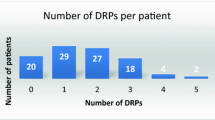Abstract
Background Prescription evaluation by pharmacists has potential to improve pharmacotherapy management. It requires the use of robust methods to identify drug-related problems (DRP), which are important issues in pharmacotherapy. Objective To evaluate the applicability and reliability of Grupo de Investigação em Cuidados Farmacêuticos (GIGUF) method for prescription analysis, identification and classification of drug-related problems in inpatients prescriptions. Setting Department of Medical Clinic of a tertiary and teaching Brazilian hospital. Method An observational and retrospective study of identification and classification of drug-related problems. GIGUF method was used to evaluate prescriptions of hematological patients hospitalized between August and October 2015. The problems were categorized using GICUF-method classification. Three pharmacists performed inter-rater agreement analysis of the method using Kappa. Differences in prevalence of DRP was calculated by age, sex, pharmacotherapy complexity, length of stay and number of drugs. Main outcome measure (a) frequency and characteristics and (b) inter-rater agreement in identification and classification of the drug-related problems. Results A total of 211 problems were identified and ‘inadequate dosing' was the most common problem. There was an association between the occurence of a drug-reklated problem and complexity of pharmacotherapy (p = 0.001) and number of drugs used (p = 0.010). The overall inter-rater agreement was moderate (k = 0.44 IC 95% 0.34–0.55) and the problem ‘not suitable drug' (k = 0.55 IC 95% 0.44–0.66) had greater inter-rater agreement. Conclusion The method “Evaluation Drug Use Process” was useful for prescription analysis since it made the identification and classification of DRPs possible. The method demonstrated a moderate inter-rater agreement, and can contribute to pharmacotherapy management by hospital pharmacists.

Similar content being viewed by others
References
Pharmaceutical Care Network Europe (PCNE). PCNE classification of drug-related problems (V8.01). 2017. https://www.pcne.org/upload/files/215_PCNE_classification_V8-01.pdf. Accessed on 17 Aug 2018.
Maes KA, Tremp RM, Hersberger KE, Lambert ML. Demonstrating the clinical pharmacist’s activity: validation of an intervention-oriented classification system. Int J Clin Pharm. 2015;37(6):1162–71.
Tigabu BM, Kaba D, Habte B. Drug-related problems among medical ward patients in Jimma university specialized hospital, Southwest Ethiopia. J Res Pharm Pract. 2014;3(1):1–5.
Blix HS, Viktil KK, Reikvam A, Moger TA, Hjemaas BJ, Pretsch P, et al. The majority of hospitalised patients have drug-related problems: results from a prospective study in general hospitals. Eur J Clin Pharmacol. 2004;60(9):651–8.
Malfará M, Pernassi M, Aragon D, Carlotti A. Impact of the clinical pharmacist interventions on prevention of pharmacotherapy related problems in the paediatric intensive care unit. Int J Clin Pharm. 2018;40(3):513–9.
Hohmann C, Eickhoff C, Klotz JM, Schulz M, Radziwill R. Development of a classification system for drug-related problems in the hospital setting (APS-Doc) and assessment of the inter-rater reliability. J Clin Pharm Ther. 2012;37(3):276–81.
Kaboli PJ, Hoth AB, McClimon BJ, Schnipper JL. Clinical pharmacists and inpatient medical care: a systematic review. Arch Intern Med. 2006;166(9):955–64.
Lenssen R, Heidenreich A, Schulz J, Trautwein C, Fitzners C, Jaehde U, et al. Analysis of drug-related problems in three departments of a German University hospital. Int J Clin Pharm. 2016;38(1):119–26.
Prot-Labarthe S, Di Paolo ER, Lavoie A, Quennery S, Buss-ières J, Brion F, et al. Pediatric drug-related problems: a multicenter study in four French-speaking countries. Int J Clin Pharm. 2013;35(2):251–9.
Kaufmann CP, Tremp R, Hersberger KE, Lampert ML. Inappropriate prescribing: a systematic overview of published assessment tools. Eur J Clin Pharmacol. 2014;70(1):1–11.
Iglesias-Ferreira P, Dispensação Clínica de Medicamentos. In: Infopharma. Revista da Associação de Farmácias de Portugal, 2010. https://pharmcare.pt/wp-content/uploads/file/Artigos/dcm_inphofarma.pdf. Accessed 20 Jan 2019.
Ferreira TXAM, Prudente LR, Dewulf NLS, Provin MP, Mastroianni PC, Silveira EA, et al. Medication dispensing as an opportunity for patient counseling and approach to drug-related problems. Braz J Pharm Sci. 2016;52(1):151–62.
Melchiors AC, Correr CJ, Fernández-Limos F. Tradução e Validação para o Português do Medication Regimen Complexity Index. Arq Bras Cardiol. 2007;89(4):210–8.
Cohen JA. Coefficient of agreement for nominal scales. Educ Psychol Meas. 1960;20(1):37–46.
Fleiss JL. Measuring nominal scale agreement among many raters. Psychol Bull. 1971;76(5):378–82.
Sim J, Wright CC. The kappa statistic in reliability studies: use, interpretation, and sample size requirements. Phys Ther. 2005;85(3):257–68.
Guignard B, Bonnabry P, Perrier A, Dayer P, Desmeules J, Samer CF. Drug-related problems identification in general internal medicine: the impact and role of the clinical pharmacist and pharmacologist. Eur J Intern Med. 2015;26(6):399–406.
Torner MQG, Estradé EO, Solernou FP. Atención farmacéutica en los problemas relacionados con los medicamentos en enfermos hospitalizados. Farm Hosp. 2003;27(5):280–9.
Souza TT, Godoy RR, Rotta I, Pontarolo R, Fernandez-Llimos F, Correr CJ. Morbidade e mortalidade relacionadas a medicamentos no Brasil: revisão sistemática de estudos observacionais. Rev Ciênc Farm Básica Apl. 2014;35(4):519–32.
Farias TF, Aguiar KS, Rotta I, Belletti KMS, Carlotto J. Implementação de um serviço farmacêutico clínico em hematologia. Einstein. 2016;14(3):384–90.
Ferreira JM, Galato D, Melo AC. Medication regimen complexity in adults and the elderly in a primary healthcare setting: determination of high and low complexities. Pharm Pract. 2015;13(4):1–9.
Silva C, Ramalho C, Luz I, Monteiro J, Fresco P. Drug-related problems in institutionalized, polymedicated elderly patients: opportunities for pharmacist intervention. Int J Clin Pharm. 2015;37(2):327–34.
Hanlon JT, Schmader KE, Samsa GP, Weinberger M, Uttech KM, Lewis IK, et al. Method for assessing drug therapy appropriateness. J Clin Epidemiol. 1992;45(10):1045–51.
Viera AJ, Garrett JM. Understanding interobserver agreement: the kappa statistic. Fam Med. 2005;37(5):360–3.
Acknowledgements
The authors would like to thank the staff of the University Hospital, Federal University of Goias, as well as Henrique Santos, Pharm.D.
Funding
No funding was received.
Author information
Authors and Affiliations
Corresponding author
Ethics declarations
Conflicts of interest
The authors have no conflicts of interest to declare.
Additional information
Publisher's Note
Springer Nature remains neutral with regard to jurisdictional claims in published maps and institutional affiliations.
Rights and permissions
About this article
Cite this article
Modesto, A.C.F., Ribeiro, A.M., Pereira, J.L. et al. Evaluation of a method for drug-related problems identification and classification in hospital setting: applicability and reliability. Int J Clin Pharm 42, 193–200 (2020). https://doi.org/10.1007/s11096-019-00957-6
Received:
Accepted:
Published:
Issue Date:
DOI: https://doi.org/10.1007/s11096-019-00957-6



